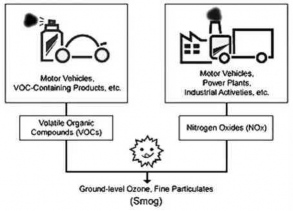5.2.2. Smog
♤ The term smog was first used (1905) by Dr H A Des Voeux
♤ Smog has been coined from a combination of the words fog and smoke. Smog is a condition of fog that had soot or smoke in it.
The Formation of Smog
♤ Photochemical smog (smog) is a term used to describe air pollution that is a result of the interaction of sunlight with certain chemicals in the atmosphere.
♤ One of the primary components of photochemical smog is ozone.
♤ While ozone in the stratosphere protects earth from harmful UV radiation, ozone on the ground is hazardous to human health.
♤ Ground-level ozone is formed when vehicle emissions containing nitrogen oxides (primarily from vehicle exhaust) and volatile organic compounds (from paints, solvents, printing inks, petroleum products, vehicles, etc.) interact in the presence of sunlight.

♤ Smog refers to hazy air that causes difficult breathing conditions. It is a combination of various gases with water vapour and dust.
♤ Its occurrences are often linked to heavy traffic, high temperatures, and calm winds. During the winter, wind speeds are low and cause the smoke and fog to stagnate near the ground; hence pollution levels can increase near ground level.
♤ Smoke particles trapped in the fog gives it a yellow/ black colour and this smog often settled over cities for many days.
Ground-level ozone is formed through a complex reaction involving hydrocarbons, nitrogen oxides, and sunlight. It is formed when pollutants released from gasoline, diesel-powered vehicles and oil-based solvents react with heat and sunlight.
